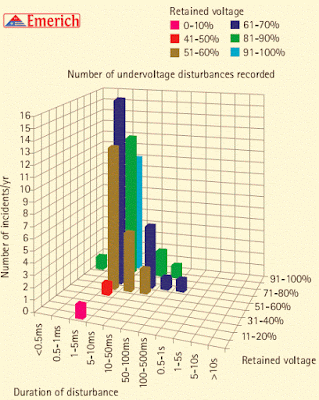 A voltage sag or voltage dip is a short duration reduction in rms voltage which can be caused by a short circuit, overload or starting of electric motors. A voltage sag happens when the rms voltage decreases between 10 and 90 percent of nominal voltage for one-half cycle to one minute.
A voltage sag or voltage dip is a short duration reduction in rms voltage which can be caused by a short circuit, overload or starting of electric motors. A voltage sag happens when the rms voltage decreases between 10 and 90 percent of nominal voltage for one-half cycle to one minute.
Its also explained as short, temporary drop in the voltage magnitude in the distribution or customer's electrical system. It may be caused by various faults in the transmission and distribution networks, faults in the connected equipment or high inrush and switching currents in the customer's installation.
What is causing voltage dips?
Figure 1 shows the sketch of a voltage dip, together with the associated definitions. The major cause of voltage dips on a supply system is a fault on the system, that is sufficiently remote electrically that a voltage interruption does not occur.
Other sources are the starting of large loads (especially common in industrial systems), and, occasionally, the supply of large inductive loads.
 |
| Figure 1 - Voltage dip sketch |
Voltage dips due to the latter are usually due to poor design of the network feeding the consumer. A voltage dip is the most common supply disturbance causing interruption of production in an industrial plant.
Faults on a supply network will always occur, and in industrial systems, it is often practice to specify equipment to ride-through voltage dips of up to 0.2s. The most common exception is contractors, which may well drop out if the voltage dips below 80% of rated voltage for more than 50-100ms.
Motor protection relays that have an under voltage element setting that is too sensitive is another cause. Since contactors are commonly used in circuits supplying motors, the impact of voltage dips on motor drives, and hence the process concerned, requires consideration.
 |
| Figure 2: multiple-voltage-dip emerich |
Other network-related fault causes are weather–related (such as snow, ice, wind, salt spray, dust) causing insulator flash over, collisions due to birds, and excavations damaging cables. Multiple voltage dips, as illustrated in Figure 2, cause more problems for equipment than a single isolated dip.
The impact on consumers may range from the annoying (non-periodic light flicker) to the serious (tripping of sensitive loads and stalling of motors). Where repeated dips occur over a period of several hours, the repeated shutdowns of equipment can give rise to serious production problems.
Figure 3 shows an actual voltage dip, as captured by a Power Quality recorder.
 |
| Figure 3 - Recording of a voltage dip |
Typical data for under voltage disturbances on power systems during evolving faults are shown in Figure 4.
 |
| Figure 4 - Under voltage disturbance histogram |
Disturbances that lie in the front right-hand portion of the histogram are the ones that cause most problems
